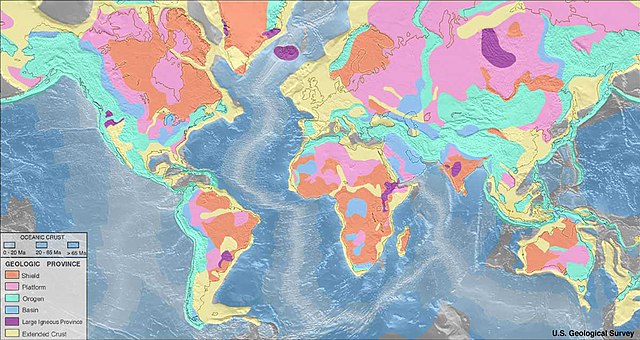Loading AI tools
Spatial entity with common geologic attributes From Wikipedia, the free encyclopedia
A geologic province is a spatial entity with common geologic attributes.[1] A province may include a single dominant structural element such as a basin or a fold belt, or a number of contiguous related elements. Adjoining provinces may be similar in structure but be considered separate due to differing histories.

This article includes a list of general references, but it lacks sufficient corresponding inline citations. (May 2014) |
| Province | Definition | Subcategories | Examples |
|---|---|---|---|
| Shield | Exposed Precambrian crystalline igneous and metamorphic rocks that form tectonically stable areas | ||
| Platform | Horizontal or gently-lying sedimentary strata covering a basement of igneous or metamorphic rocks | ||
| Orogen | Linear or arc-shaped formation where continental crust has been folded, deformed and uplifted to form mountain ranges | ||
| Basin | Low-lying formation of rock strata formed by tectonic warping of previously horizontal strata | ||
| Large igneous province | Accumulation of igneous rocks, including liquid rock (intrusive) or volcanic rock formations (extrusive) | ||
| Extended crust | Continental crust thinned due to extensional strain |

Some studies classify provinces based upon mineral resources, such as mineral deposits. There are a particularly large number of provinces identified worldwide for petroleum and other mineral fuels, such as the Niger Delta petroleum province.
Seamless Wikipedia browsing. On steroids.
Every time you click a link to Wikipedia, Wiktionary or Wikiquote in your browser's search results, it will show the modern Wikiwand interface.
Wikiwand extension is a five stars, simple, with minimum permission required to keep your browsing private, safe and transparent.